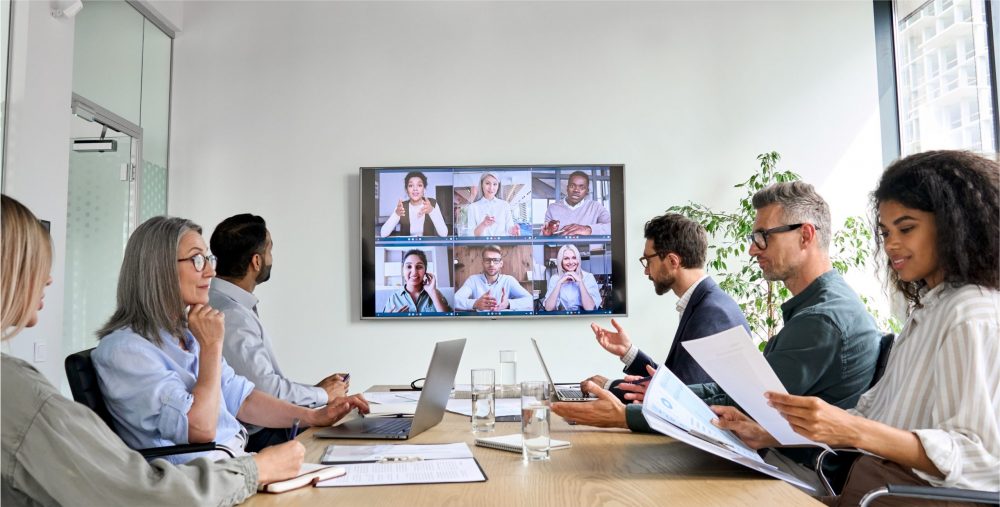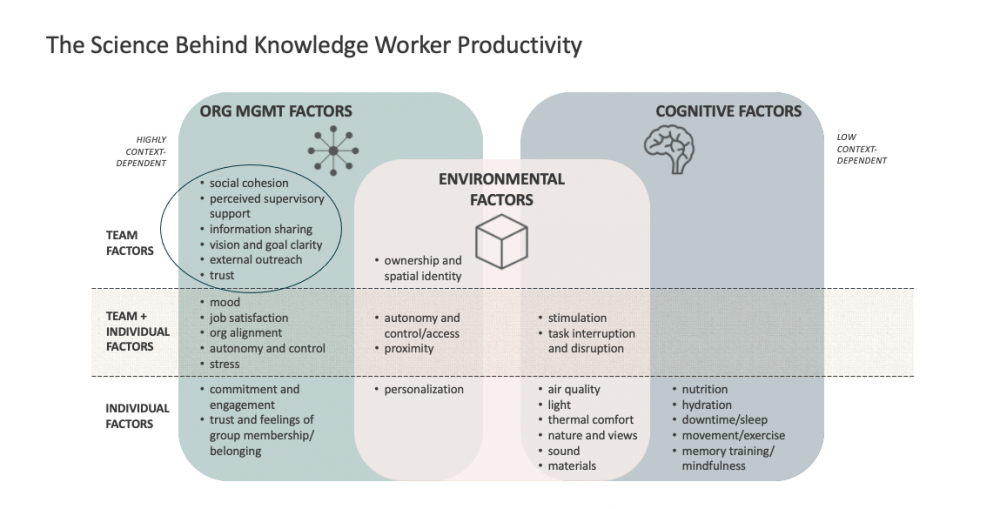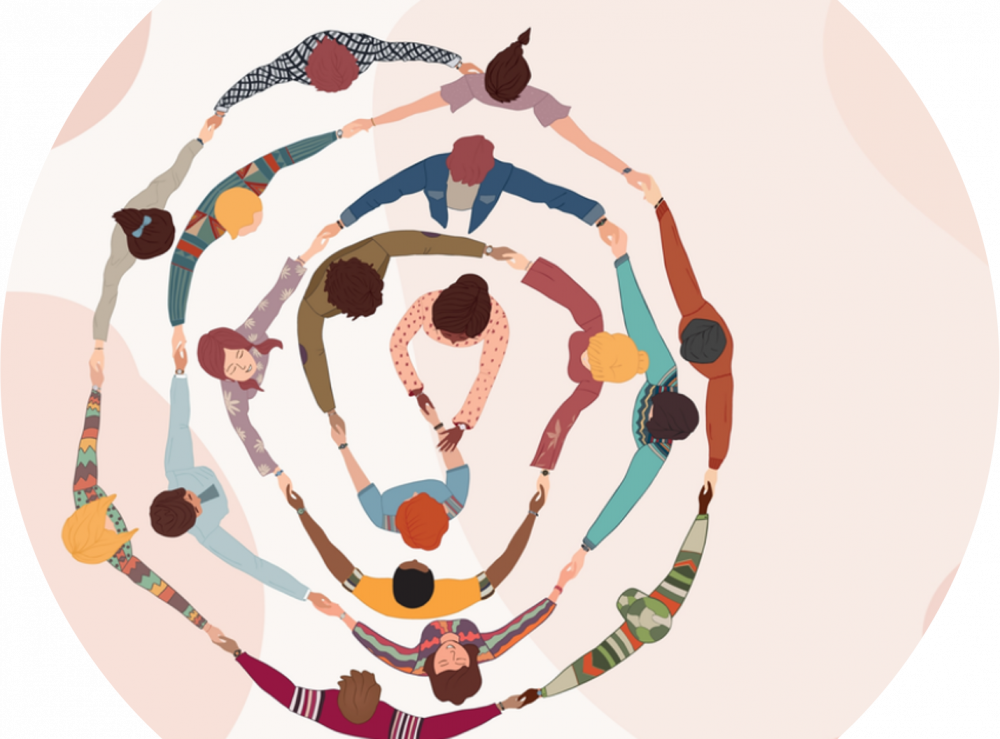Jan Johnson and Kelly Colón share 6 key factors that will enable organizations to migrate from the past office-centric workplace to a human-centered office.

We’re all pretty clear that the physical workplace and how, where, and when we work is at an inflection point. While the pandemic forced organizations and employees to pivot how and where they work overnight, for many returning to the “before times” has been met with staunch resistance — and rightly so. We say that because the initial solution isn’t purely spatial, and coming back to the office en masse isn’t going to magically fix DEI, the pressures on parents, or any of the other chronic challenges of work that affect our individual and collective effectiveness. It is about interpersonal relationships and how we engage with each other and work together.
For decades most employees and employers took the office for granted. We created centralized places we navigated in highly predictable ways, showing up during a prescribed set of hours and during a defined number of days. We assumed we would usually see our colleagues – without focusing on why this was important. We gave little thought to nor did we question why a physical centralized location was the societal norm – we simply showed up and learned “how we do things there.” And managing office space over time was mostly focused on cost control and the cycle of real estate events.
It’s obvious now that these antiquated and outdated workplace models and expectations are inefficient, performative, bastions of quiet quitting, and clearly focused on the wrong things.

Even now, organizations are urging workers to return to the office – citing improved innovation, collaboration and culture as the goal – as though the lack of physical togetherness — in and of itself — was the issue. Don’t get us wrong – proximity matters, being in each other’s presence makes communication and connections way stronger and easier – but there are so many other ways to strengthen performance, motivation, engagement, satisfaction, and a sense of belonging and not just trust that co-location will inevitably bring about these things. The difference is in intentionality, effort and actions.
Let’s also debunk the myths of workplace challenges pre and post-pandemic and start with occupancy: One client shared with us pre-pandemic, on average, only 45% of hourly workers, 36% of salaried workers and only 18% of contractors were on site each day. Those pre-2020 occupancy numbers are not that far off from what organizations are reporting today. And many of those organizations who feel they’re experiencing challenges with engagement, connection, collaboration, and innovation – not to mention attraction and retention of talent today – had those same issues pre-pandemic.
So, what efforts and actions are we proposing our organizations focus on while the playbook for resizing/redesigning workplaces is still being developed?
Make no mistake – as hybrid and distributed work patterns continue to evolve there is a lot we can to do to right-design our spaces and expand the range of places we consider “workplaces.” That’s what our second article will cover. But way more importantly, we also have a significant amount of work to do to rebuild trust and the quality of our interpersonal relationships and our connections to our organizations.

There are two types of efforts for doing this work – both designed to foster trust.
- Encourage actions that leverage the science around knowledge worker performance to influence/strengthen our cultures and interpersonal relationships – to harness the power of social cohesion to drive an increase in team productivity, collaboration, improve motivation and engagement and foster trust.
- Recalibrate our assumptions and expectations around the physical workplace to move beyond outdated office-centric towards a more human-centered workplace to enable organizations to provide the appropriate mix and types of spaces designed to support employees and the work they are being asked to accomplish when doing so in the office is optimal.
By intentionally reshaping our assumptions, intentions, behaviors and the design process itself to be more equitable, empathic, authentic, mutually supportive and trusting, we will help bridge the gap between what employees want and employers provide and transform our physical workplaces.
While our second article (coming soon) will discuss workplace design best practices in more detail, we’ll briefly point out the power human-centered workplace design has as both a design philosophy and a design process that keeps people and their activities and behaviors as the central focus; and where those who are most impacted by the challenge or problem are included and empowered to design and solve for the problem. This iterative process is about persistent engagement and proactive, iterative ideation and accommodation, and not highhanded prescription.
By keeping the lived experiences of our employees as the central focus in this design process, it inspires organizations to build intentional and nuanced workplaces solutions to nurture those employees and optimize the work they do.

Employees who feel connected to the process and empowered to drive solutions that are designed with their teams’ and employees’ insights and ideas feel a greater sense of connection to their organizations, their colleagues, and their teams also strengthen social cohesion and all the benefits it confers.
We’ve shared research in the past that identified 6 key factors which have been proven to have the highest correlation to knowledge worker productivity and are directly tied to interpersonal relationships and behaviors in the workplace. These are powerful signposts on the path to healing the disconnects between employees and employers and are more relevant than ever.

These six factors are outlined below in order of the strength of their correlation to performance:
1. Social Cohesion
The first factor and the strongest proxy for team productivity is Social Cohesion. Social Cohesion describes the quality of the personal connections we make when we build rapport and respect for each other and are invested in each other’s success. It’s essential to great teamwork and unifying over a common goal or purpose –and is proven not only to be the highest predictor of team productivity, but makes the exchange of ideas more likely, and creates a psychologically safe environment to share those ideas and take risks. It can also be directly linked to individual performance, increased motivation and engagement, and increases resilience in the face of fear, stress, and anxiety.
2. Perceived Supervisory Support
The second factor is Perceived Supervisory Support – when employees feel their boss has their back. Employees feel supported and connected to their organizations through leaders who foster a sense of purpose, help their employees resolve interpersonal conflicts and get access to needed resources, set clear expectations, and hold each other accountable in consistent ways. You’ve heard the phrase “People join organizations; they quit bosses.”
3. Information Sharing
There are two parts to this; freely sharing what we know to help solve immediate challenges, while also creating a collective memory (“transactive memory systems”) within the organization and the team that can be called upon in the future. Both aspects build trust and improve decision making.

4. Vision and Goal Clarity
We all crave a sense of purpose. Vision and Goal Clarity operates on several levels – I know what’s expected of me, of my team and how my teams’ contributions ladder up to the organization’s overall strategy. This allows employees and teams to prioritize their time more effectively. Clear goals also allow teams and employees to connect their personal and team values and experience more meaning and self-affirmation from their work. A clear vision provides both a rational for the teams’ existence and standards by which the team and employees performance can be measured.
5. External Outreach and Communication
Proactively interacting with outsiders, seeking information and resources, interpreting signals and external perspectives fosters open mindedness and innovation. The more external interactions team members have with others, the more likely they are to be innovative – as access to diverse information and connections with people from different backgrounds and viewpoints reduces team pressures to conform to existing ideas and fosters creativity.
6. Trust
Trust is built when actions match works. Consistently. Trust leads to the acceptance of influence, openness in communication, team and employee empathy and cooperation. The success of a team relies on an individual team members willingness to share an exchange information and knowledge. Trust between team members promotes a shared commitment towards common goals over personal interest.

You’ll notice two things: all of these are highly interdependent and none are about physical space – but rather about how we treat each other and what binds us to our organizations. We believe the heartbeat of the organization and its culture is so much more than increasing occupancy, the physical location or number of days in an office: it’s about engagement, connection, trust.
Physical workplaces for an equitable, authentic, interdependent and sense-of-belonging-fostering organization can only be achieved if we are clear about what we are trying to accomplish and are inclusive in the process. No longer will it be enough to simply create a workplace and demand prescribed attendance and usage without understanding the needs of employees: their expectations, behaviors and motivations, and clarity over the outcomes they’re being asked to deliver; rather, it must be a systematic and an open-to-variation approach that supports the total workplace ecosystem for both employees and employers alike.
This pandemic provided employees the opportunity to re-evaluate their lives and their priorities. They are more discerning than ever regarding their workplaces and their organizations. They want to feel a sense of purpose and belonging and doing meaningful work. To feel supported, heard and valued in their organizations. To have support for their mental health and wellbeing be a top priority. To align with an organization that is fair and who’s leadership is evenhanded.
No longer will it be enough to simply create a workplace and demand prescribed attendance and usage without understanding the needs of employees…
These have always been the top reasons employees stay – but perhaps we are all just that much more clear and insistent on wanting/needing these in our lives. And we’re right in doing so – these characteristics strongly correlate to individual and team effectiveness and stellar organizational performance. These are not just “nice to haves:” but rather are THE most impactful things an organization can invest in.
While the 6 factors provide us with insights into employee productivity, motivation and engagement – and the critical impact of interpersonal relationships – human-centric design processes provide us a clear map of the journey we and our organizations can take to foster great employee experiences, a positively affective culture, and a tuned, relevant and adaptable-over-time workplace. Together these methodologies remind us of the mindset, tools and techniques that will enable organizations to migrate from the past office-centric workplace to a human-centered workplace.
Stay tuned for future articles where we identify the steps, tools and techniques organizations can take when they are looking to build a human-centered office.

